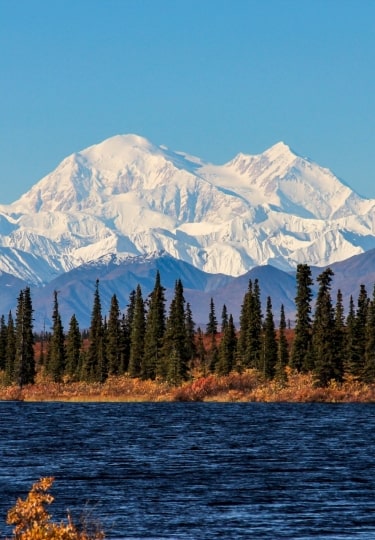Alaska is a land of snow-covered mountains, with 30 different ranges stretching across this pristine wilderness, the blue sky punctuated by 10 of the 20 highest peaks in the United States.
Whether you’re a serious mountaineer or a recreational hiker, or perhaps prefer to admire Alaska mountains from the air on a dazzling scenic flight over the icy peaks, you’ll find some of the finest excursions in the world here.
Here are some of the best mountains in Alaska to see on your next vacation to the Last Frontier.
Mount McKinley
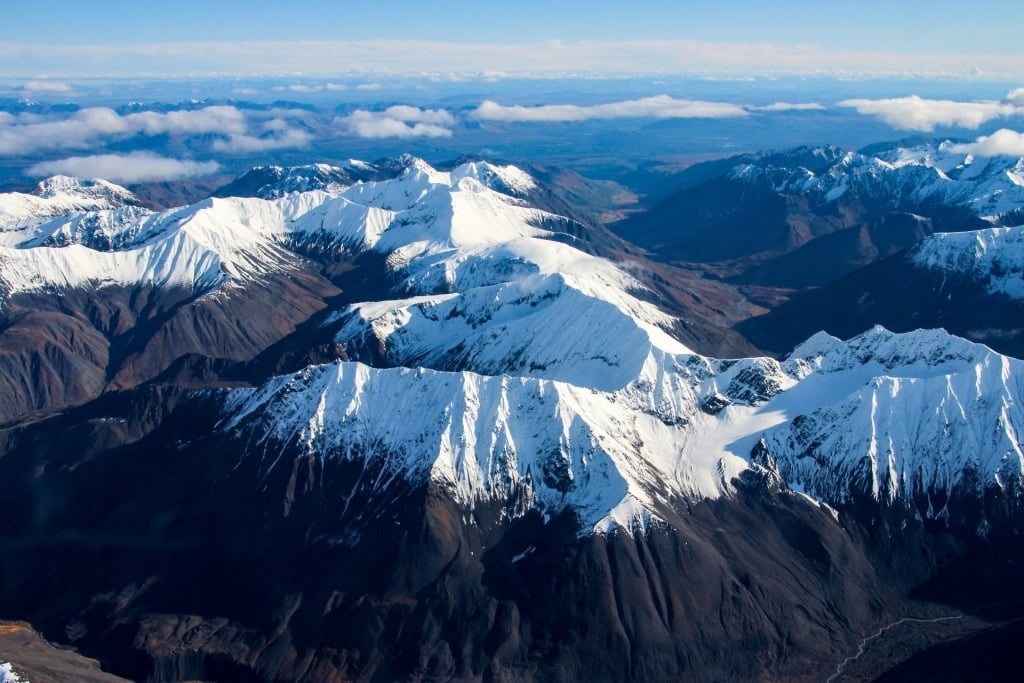
Mount McKinley
Mount McKinley, when its misty shroud melts away, is a showstopper; the most impressive of all Alaska’s mountains. A vast, 20,310-foot wall of granite, snow, and ice, the “Great One” towers over six million acres of rolling tundra, taiga forest, birch and aspen, and braided rivers. Every view here is breathtaking, every vista dominated by Mount McKinley, one of the most beautiful mountains in the world.
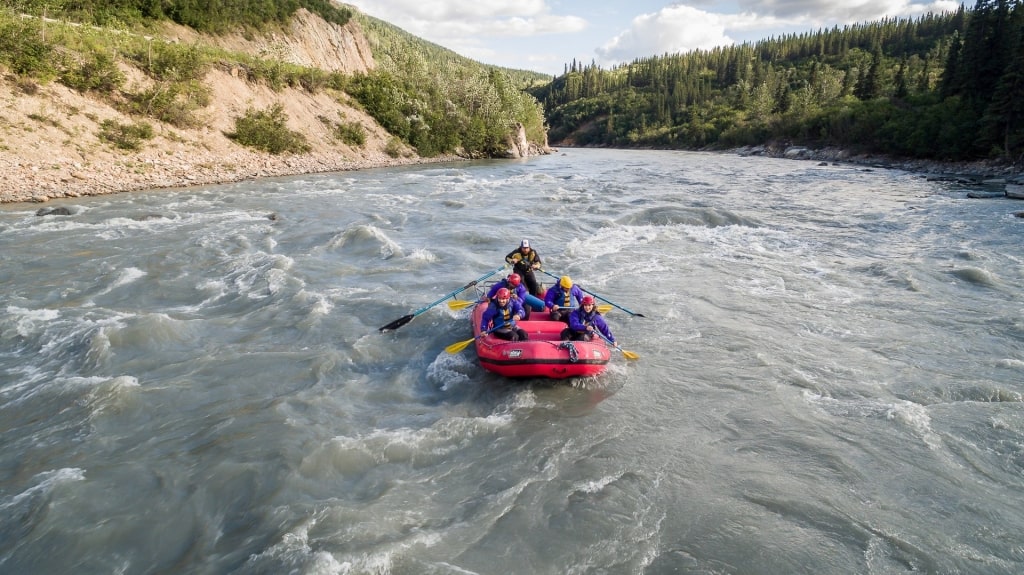
Denali National Park
While you’d have to be a serious mountaineer to tackle Mount McKinley itself, there are plenty of other ways to appreciate the highest mountain in North America. Take a helicopter tour and soar over the vast expanse of tundra, flying over rivers and treetops, the icy mass always in view. Or try an Alaskan flightseeing tour by light aircraft right over the snow-capped summit.
In the park itself, there’s thrilling white water rafting, more sedate river floating, ATV safaris, fly-fishing, and some of the best hiking in Alaska. Keep your eyes peeled for grizzlies and eagles during your visit.
Outside the park, the base for visiting Mount McKinley is the artsy, boho town of Talkeetna. It’s packed with cool restaurants and old-fashioned saloons, a permanent buzz in the air from the many climbers who flock here to prepare for their ascent. Take a stroll at sunrise or sunset to watch the light on the mountain, which almost seems to glow as burnt orange and pink streak the sky.
Read: Best Outdoor Vacation Ideas
Chugach Mountains
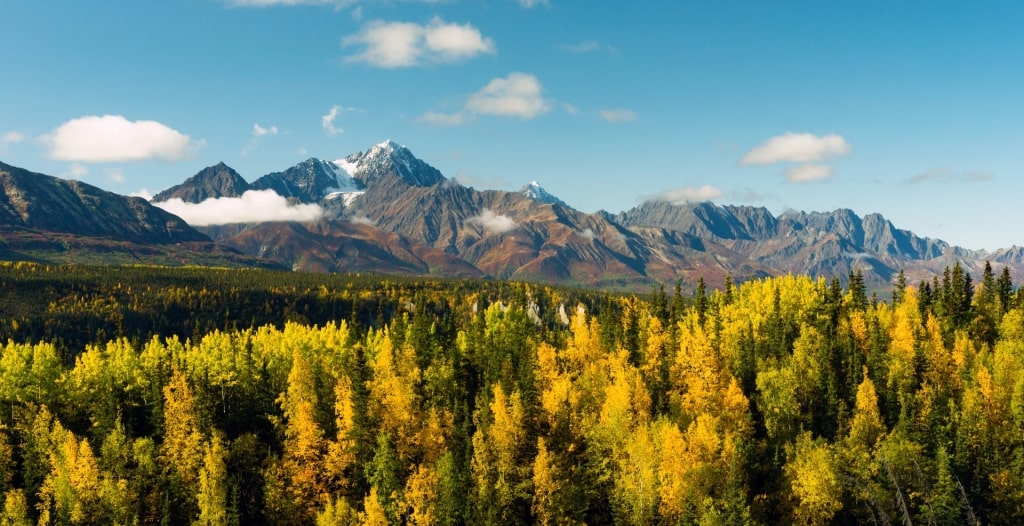
Chugach Mountains
One of the most beautiful Alaska mountain ranges, the snowy Chugach Mountains form a dazzling backdrop to Anchorage, the state’s largest city, and serve as a vast outdoor playground for locals and visitors.
Just 20 minutes from downtown, you’ll find trailheads, including starting points for various Flattop Mountain trails. Flattop is regarded as the most-climbed mountain in Alaska; from the top, which is flat, you’ll have views all the way to Mount McKinley and the Aleutian Islands.
Prefer to stay near the water? You can keep the Chugach range in view on the hike or cycle along the Tony Knowles Coastal Trail, through shady forest and along the shoreline. Don’t be surprised if you have to stop to give way to a moose or two. Or take a flightseeing tour, soaring over snow-capped peaks and some of Alaska’s beautiful glaciers.
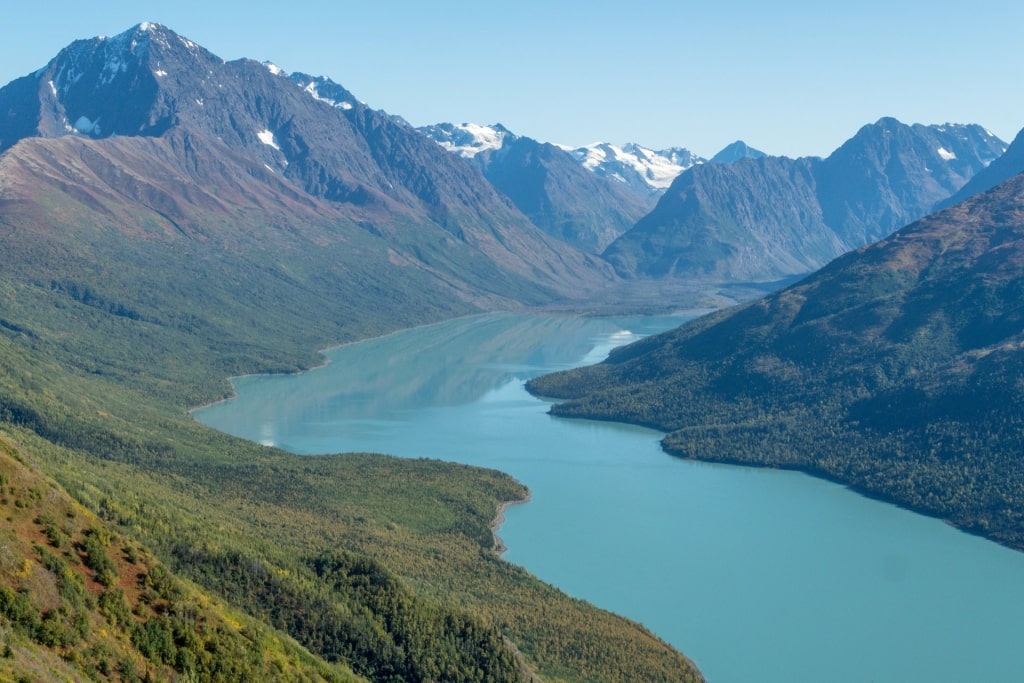
Eklutna Lake
An easy day trip from Anchorage is into the mountains to Eklutna Lake—one of the most beautiful lakes in Alaska—where densely forested banks slope into the glassy water. Join a kayaking tour across this serene spot, the majestic mountains framing every view. On the way there or back, make a stop at Thunderbird Falls, where a mile-long trail takes you through birch forest to a viewing platform over the Eklutna Canyon, with features fine views of the foaming, 100-foot falls.
Mount Alyeska
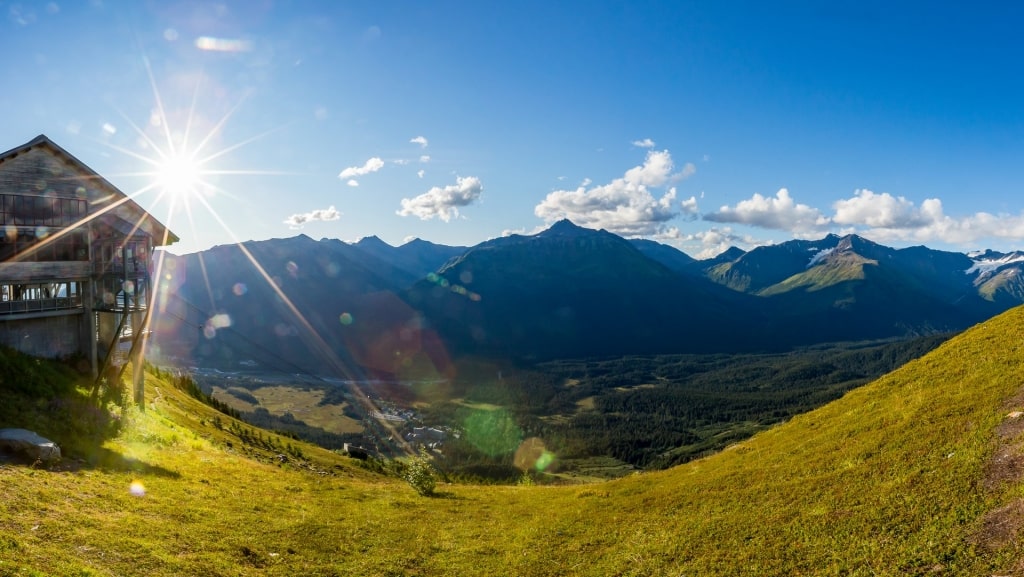
Mount Alyeska
Just 40 minutes’ drive along the scenic coast road from Anchorage and close to the city of Girdwood, Alyeska is a chic ski resort in winter and a glorious hiking and mountain biking spot in summer. The 3,939-foot mountain forms part of the Chugach range.
The easiest way to admire the mountain’s majesty is from the Alyeska Tramway, which whisks you up to 2,300 feet on a seven-minute ride you’ll never forget, with views of no less than seven hanging glaciers, vast rivers of ice suspended as they spill over surrounding mountain faces. Keep your eyes peeled for bears and moose in the forest below. At the top, the Seven Glaciers Restaurant, an AAA Four-Diamond establishment, does a fine line in classy Alaskan seafood; you’ll need to make reservations ahead for this feast.
Alternatively, go for an adrenaline boost in Alyeska’s Bike Park, which offers mountain biking trails for all levels, from a gentle cruise through flower-filled meadows to hair-raising mud trails down the mountain face.
Mount Susitna
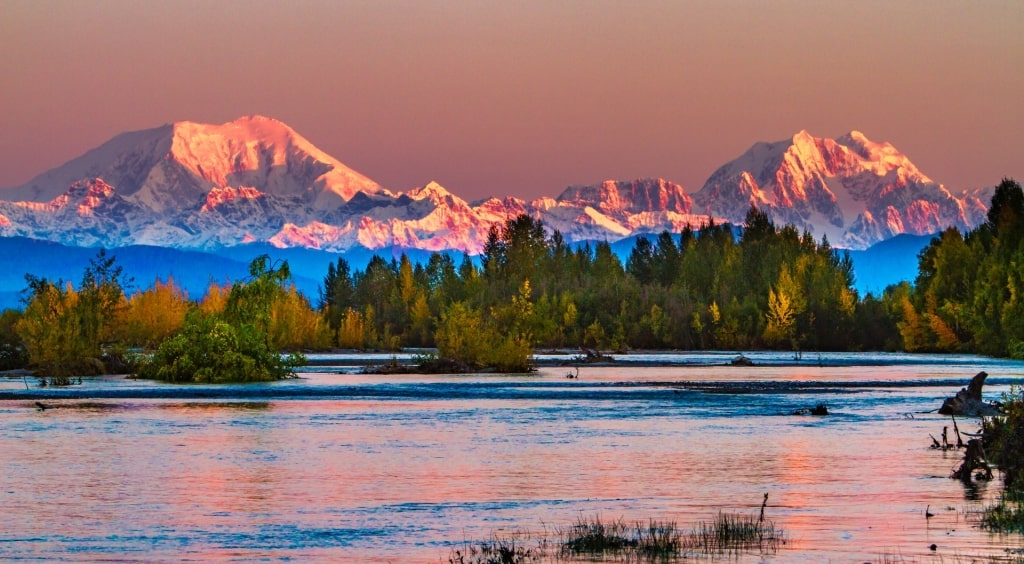
Mount Susitna
Mount Susitna, also known as the Sleeping Lady, looms on the skyline to the west of Anchorage, the Susitna River rushing along the contours of its base toward the sea. From Anchorage, the best way to see the Sleeping Lady is from the air, soaring over the Matanuska-Susitna, Eklutana, Chickaloon, and Knik glaciers.
On a longer journey from Anchorage, you could even circle Mount McKinley, flying over lower but no less beautiful mountain ranges en route: the Chugach Mountain Range, Talkeetna Mountain Range, and the Sleeping Lady herself, coming in low over the Susitna River watershed on the lookout for wildlife.
Even if you don’t make it to Susitna, the views from Anchorage itself at sunset are magnificent. Locals head to the beach at Point Woronzof, which is actually the end of the runway of Anchorage’s airport, to watch as the setting sun turns the distant slopes a fiery orange.
Read: Things to Do in Downtown Anchorage
Kenai Mountains
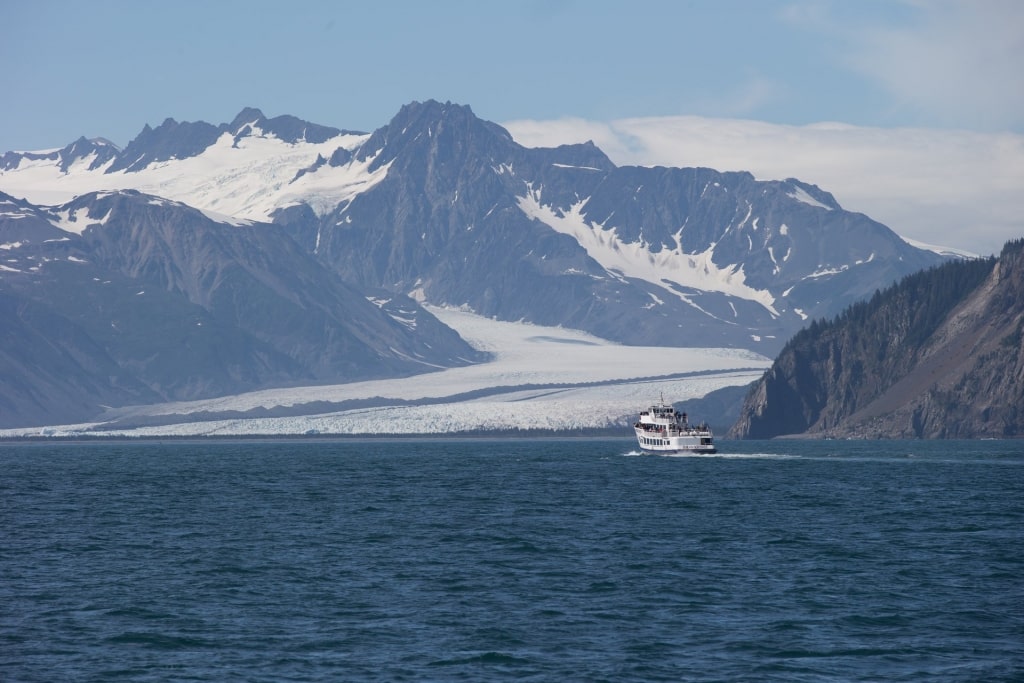
Kenai Mountains
The Kenai mountain range forms a backdrop of snow and ice to the city of Seward and the glassy fjords of the Kenai Fjord National Park. The deep cobalt of the water here makes the contrast with the jagged white peaks, cloaked year-round by the mighty Harding Icefield, all the more striking.
Some of the most popular things to do in Seward tend to be on the water, as Resurrection Bay is perfect for sea kayaking—and rich in marine mammals, too. So if you want to admire the majesty of these Alaska mountains, take to the air. Swoop low over blue-white glaciers in a helicopter, and soar over peaks frosted with white. Keep an eye out for wildlife along the sheer cliffs and deep valleys, or the blow of a whale in the water.
Some operators offer some of the most exciting tours of Alaska’s mountains where you’ll actually land on one of the glaciers amid a sea of frozen white pinnacles, crevasses plunging to sapphire depths.
Read: Incredible National Parks to Visit in Alaska
Mount Marathon
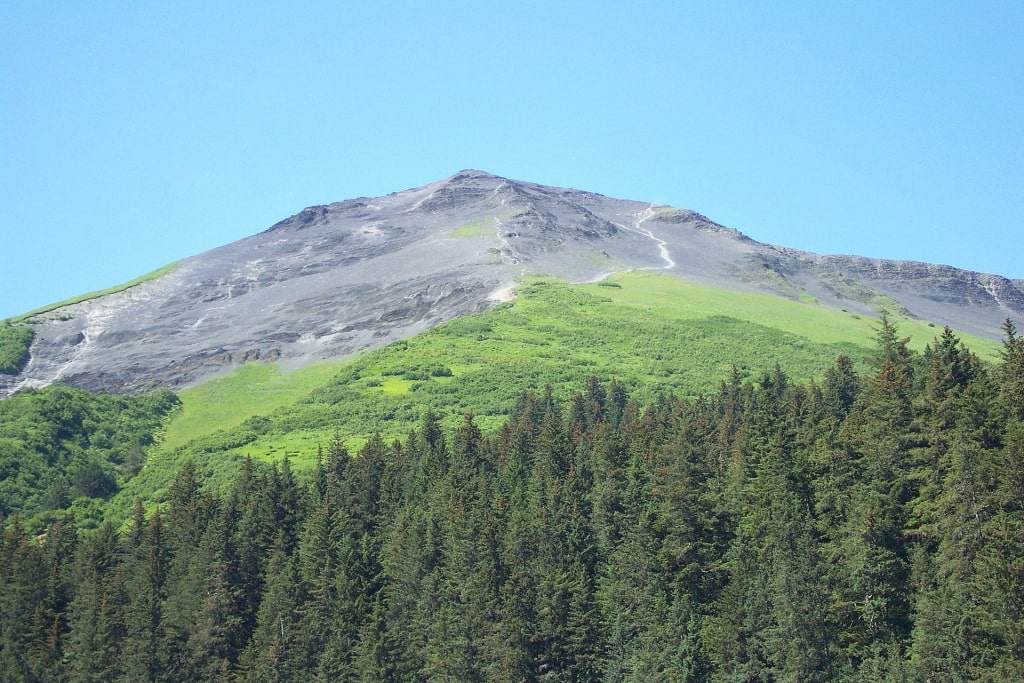
Mount Marathon
Looming over Seward, Mount Marathon is famed for the grueling annual Independence Day race that draws 1,000 runners from all over Alaska. The three-mile race involves scaling the 3,022-foot rock face, with the halfway point at the top, and then staggering back down. Runners often arrive back in Seward plastered in mud and riddled with cuts and bruises. Marathon is without a doubt one of the toughest Alaska mountains.
You can tackle Mount Marathon yourself at a more realistic pace and follow the Jeep Trail, rather than the punishing Runner’s Trail. Two further trails take you on a four-and-a-quarter-mile hike from downtown to the Summit Ridge and back, passing through spruce forest and up above the treeline.
From the highest point, on a fine day, you can see the entire length of Resurrection Bay, as well as the vast white sheet of the Harding Icefield. You’ll need to be physically fit, but this is a superb hike and can be done in a day.
The Boundary Ranges
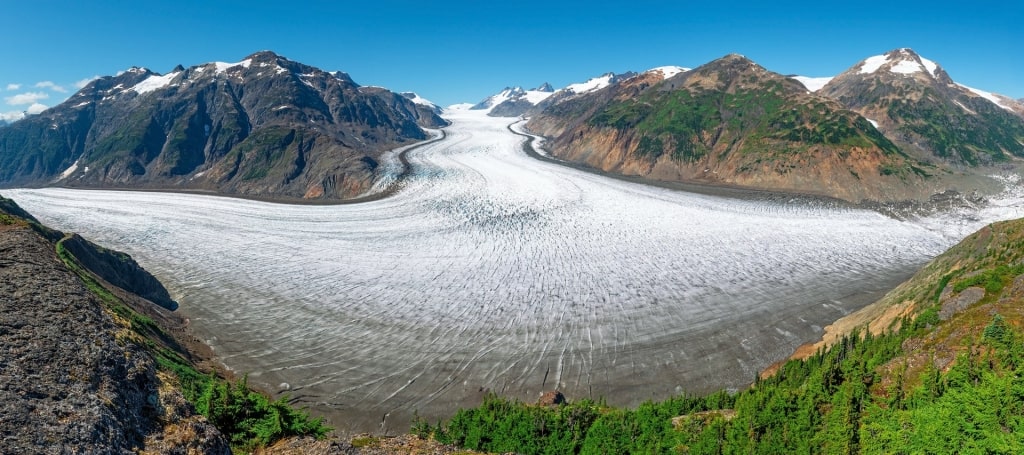
The Boundary Ranges
The Boundary Ranges form a jagged spine stretching hundreds of miles north from the border between Alaska and British Columbia. Their most famous crossing point is the White Pass, which is accessible from the former Gold Rush town of Skagway.
During the Gold Rush, before the completion of the narrow-gauge White Pass & Yukon Route railroad, the infamous White Pass was a treacherous route over the coastal mountains to Lake Bennett and the goldfields. Sections of the pass are visible from the railroad, which is arguably one of the most beautiful places in Alaska and an absolute must if you’re visiting Skagway.
The train climbs high into the Alaska mountains, ascending from sea level to 2,865 feet in just 20 miles, rattling through forested valleys and over rushing rivers. Every now and then, you’ll have an insight into the near-impossible terrain the prospectors had to tackle, which was steep, rocky, and dangerous.
Mount Roberts
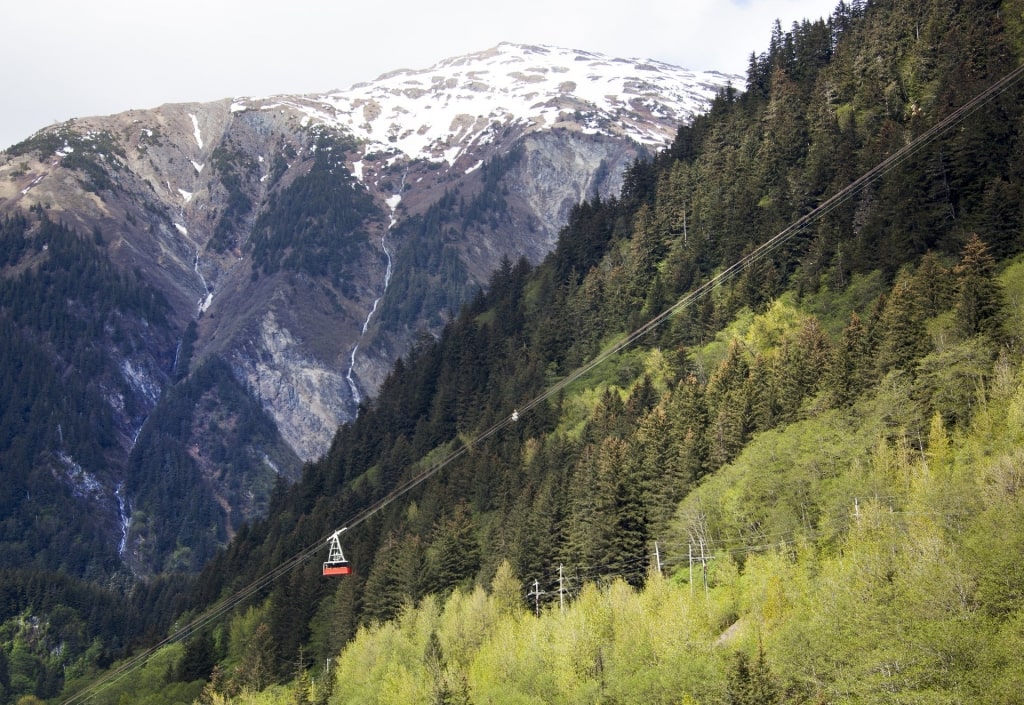
Mount Roberts
Mount Roberts towers behind the state capital, Juneau, the town huddled on a narrow strip between the forested slopes and the sparkling Gastineau Channel. With proper gear and a decent level of physical fitness, the hike from the town to the summit takes about four knee-trembling hours.
Thankfully, there’s an easier way. The Mount Roberts Tramway glides 1,800 feet from the town to the top in just five minutes. Needless to say, the views down over the port, the water, and towards the distant Chilkat Mountains are stupendous. Take in the view, visit the interpretation center, and enjoy fresh Alaskan food and craft beers at the Timberline Restaurant.
For gentler walks, there are mountaintop hiking trails to explore. Stroll through the temperate rainforest and across alpine meadows, sprinkled with flowers in every color of the rainbow. Keep an eye out for wildlife as you walk—black bears live in the forest here, while bald eagles soar overhead. You may even spot the chubby-cheeked whistling marmot.
Hoonah Mountain
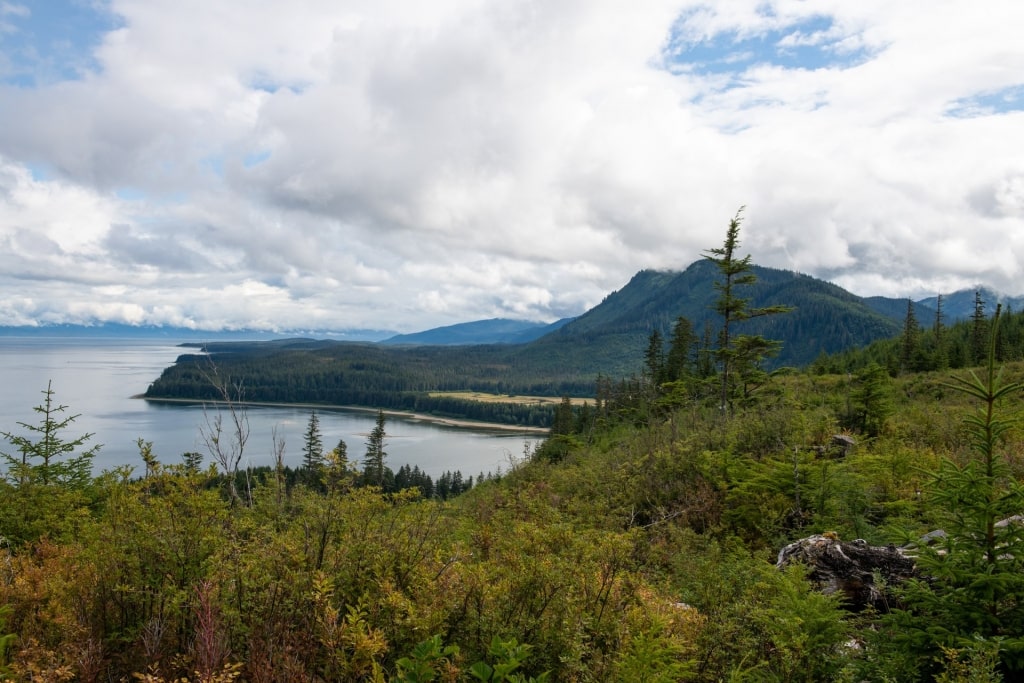
Hoonah Mountain
Forested Hoonah Mountain towers over the village of Hoonah and the little port of Icy Strait Point, deep in the Inside Passage on Chichagof Island, a wild, remote spot. Chichagof’s claim to fame is that more brown bears than humans live here.
You can search for the island’s bears on the forest trails along the Spasski River, as well as black-tailed deer and bald eagles. Thrill-seekers, though, head up the mountain. Pass through magnificent old-growth forest to fly down its wooded slope on the world’s largest Ziprider. Six zip lines, 5,330-feet long, whizz you at speeds of up to 60 miles per hour over the forest canopy, plummeting through a dramatic descent of 1,330 feet.
Once you’ve conquered the Ziprider, there’s plenty more to do at Icy Strait Point, from whale watching to looking for birds in the temperate rainforest and along the shores of Point Frederick.
Read: Best Zip Lines in the World
Mount Edgecumbe
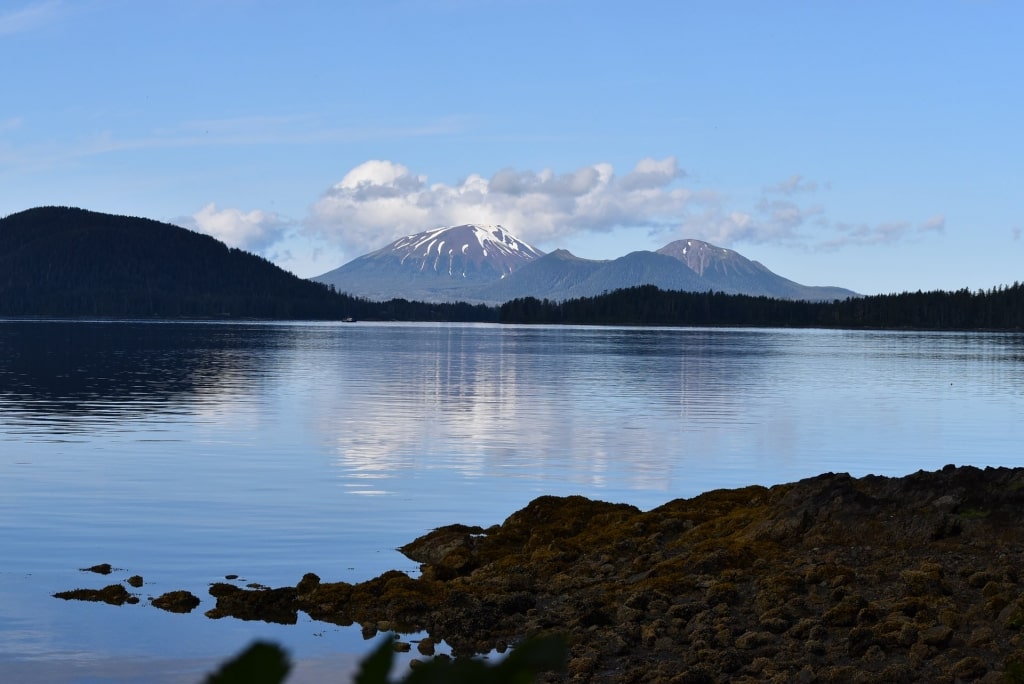
Mount Edgecumbe
The conical, 3,201-foot pyramid of Mount Edgecumbe, Alaska’s answer to Mount Fuji, rises above the Pacific on Kruzof Island some 10 miles west of Sitka. Most visitors are happy to simply gaze at the view, and possibly reflect on the mischief of a group of local pranksters and their spectacular April Fool’s joke.
On April 1, 1974, locals woke to see a plume of black smoke rising from the volcano, which had been dormant for centuries. When the coastguard flew over the crater in a helicopter, he saw a pile of burning old tires and the words “April Fool” spray-painted in the snow.
Adventurous visitors like to take on Edgecumbe, hiking to the crater rim for dazzling views out over the Pacific and inland towards serrated snowy mountain ranges. The 6.5-mile hike is extremely tough, though, taking six hours one way and starting through marshy woodland and scrambling the last couple of miles over loose pumice.
You could do a section of the trail and get out and back in the same day. A more realistic undertaking, and just as beautiful, is to take a day trip across from Sitka to Kruzof Island, looking out for whales during the crossing, for a four-hour hike along the coastline in the shadow of the volcano.
Deer Mountain
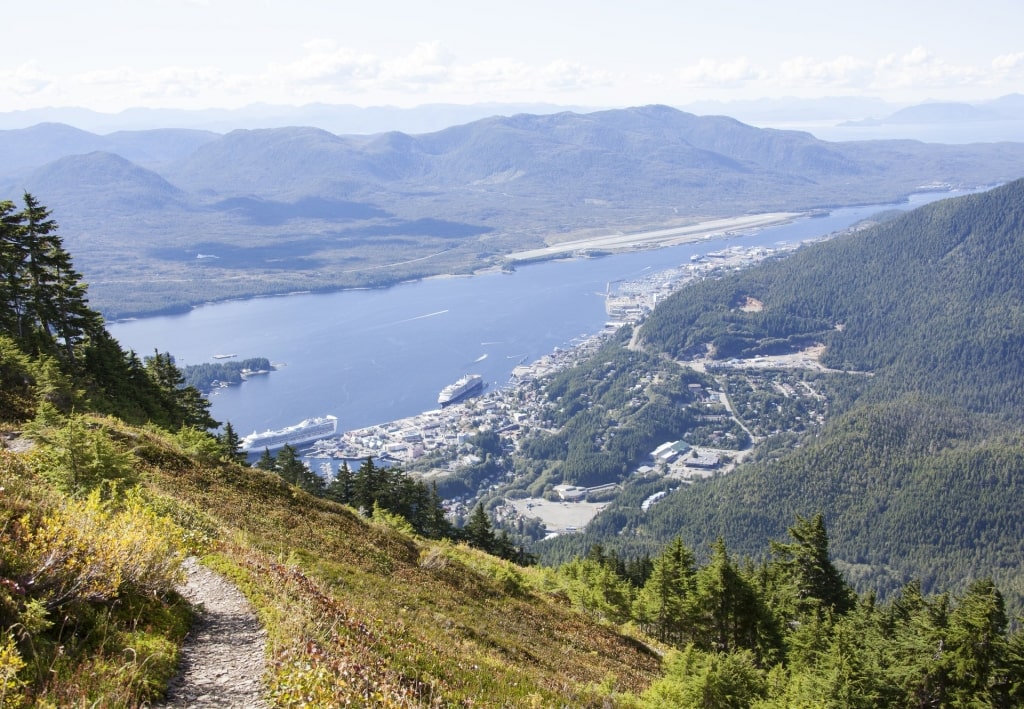
Deer Mountain
Towering over the Tongass National Forest, the snow-capped Deer Mountain forms an imposing backdrop to downtown Ketchikan. The Deer Mountain Recreation Trail, which takes you up 2,600 feet through alpine meadows, temperate rainforest, and on boardwalks across muskeg, or marshland, is regarded as one of the best day hikes in Alaska.
It’s not for the faint-hearted, though; one way takes around three and a half hours, along ridges and around steep switchbacks. Your reward is dazzling views down across the town, the water, and the Misty Fjords in the distance. The trail is an out-and-back, so for a shorter flavor of Deer Mountain, you could always tackle the first section.
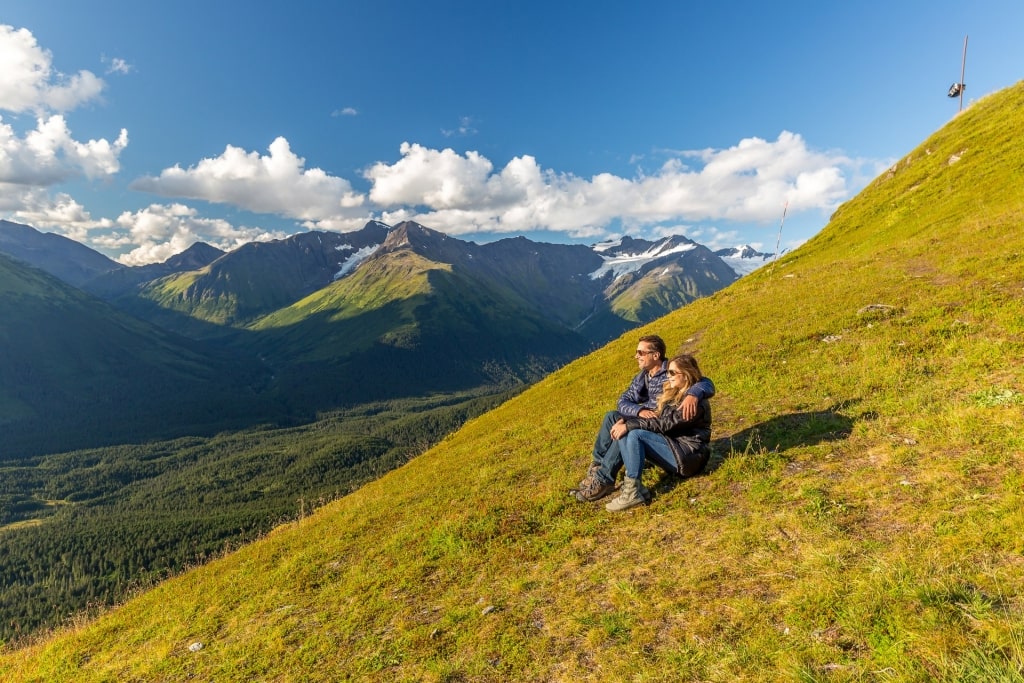
Mount Alyeska
Are you already reaching for your hiking boots? Browse our wide range of cruises to Alaska and explore these magnificent Alaskan mountain ranges.
